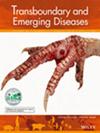Isolation, Passage, and Pathogenicity of a Newly Isolated Lawsonia intracellularis Strain From Hubei, China
Abstract
Lawsonia intracellularis is the causative agent of porcine proliferative enteropathy (PPE)—a disease of great economic impact to the global pig industry, but the isolation and continuous passage culture of this bacterial species is very difficult which limits the development of inactivated or live vaccines. While China is the largest pig rearing country in the world, only one study has reported the isolation of L. intracellularis. In this study, we examined 1574 ileal samples collected from 10 slaughterhouses in Hubei Province, China, and obtained 104 samples tested positive for L. intracellularis. From these positive samples, we successfully isolated a L. intracellularis strain designated LI-HuB23, which could be continuously passaged in IEC-18 cells. The successful isolation of LI-HuB23 was confirmed by transmission electron microscopy (TEM), indirect immunofluorescence assay (IFA), PCR amplifying, and Sanger sequencing of the marker gene (aspA). LI-HuB23 exhibited stable proliferation over 10 passages and it was still being passaged for over 30 generations. Oral inoculation of 28-day-old pigs with LI-HuB23 containing 6.9 × 108 bacterial microorganisms induced loose stools and watery diarrhea between Days 14 and 28 postinfection. Challenging pigs showed an average daily gain (ADG) lowered than the control pigs (206.05 ± 23.48 g/day vs. 241.43 ± 16.78 g/day). All challenging were serologically positive for L. intracellularis IgG at 21 days postinoculation. Histological examination detected crypt hyperplasia, characterized by a reduction in goblet cells within the hyperplastic crypts. Colonization of L. intracellularis in ileal crypts was confirmed by immunohistochemical examination.


 求助内容:
求助内容: 应助结果提醒方式:
应助结果提醒方式:


